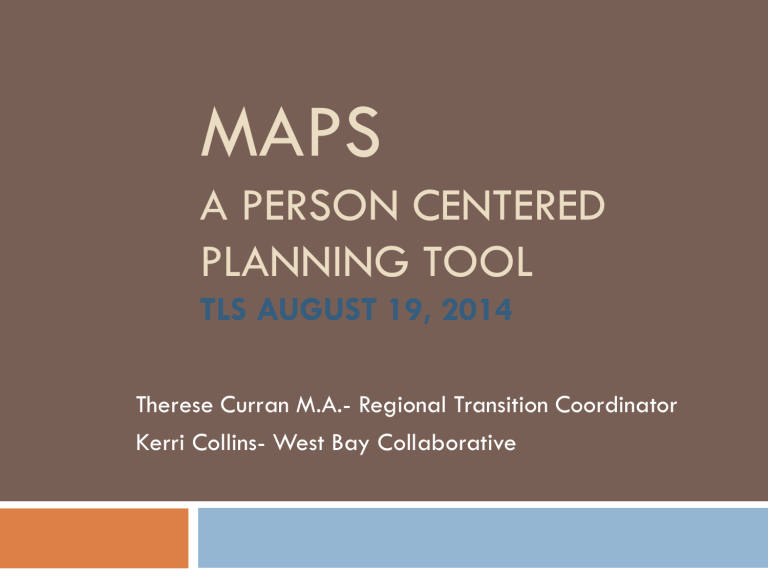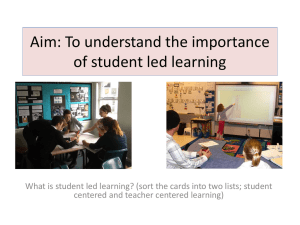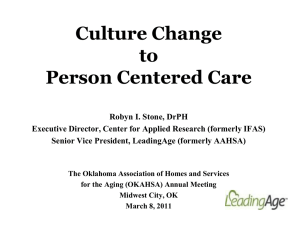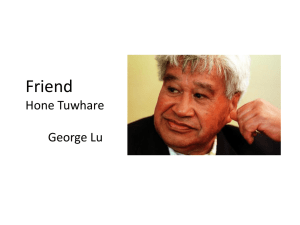Making Action Plans (MAPS)

MAPS
A PERSON CENTERED
PLANNING TOOL
TLS AUGUST 19, 2014
Therese Curran M.A.- Regional Transition Coordinator
Kerri Collins- West Bay Collaborative
MAPS
What is
Person Centered Planning?
Person centered planning is a set of approaches designed to create a vision of the future to assist someone to plan their life and supports….
It is a process for continual listening, learning and focusing on what is important to someone now and in the future.
Person Centered planning discovers and acts on what is important to the person in alliance with their family and friends
What are the outcomes of Person
Centered Planning?
“Framework of Accomplishment”
5 keys areas to shaping quality of life
Sharing places/ community
Making choices/ being empowered
Developing capacities & gifts
Being Treated with Respect and having a Valued
Social Role
Growing Relationships
How is Person-Centered Planning Different
From Traditional School Planning?
Plans WITH not FOR the student (and family)
Starts with abilities and interests, rather than disabilities
Provides a comfortable atmosphere for the student and family
Hear from the student and family FIRST
Educational and other service providers have a better understanding of family’s dreams and fears
Offers a visual and immediate picture of the situation
Provides helpful information to identify and prioritize needs
Person Centered Planning Tools
MAPS – Making Action Plans; McGill Action Plans
PATH – Planning Alternative Tomorrows with Hope
Personal Futures Planning
Dare to Dream
Circles of Support
Discovery
Philosophies
Not about…forms, or short cuts with paperwork or
“hanging out with consumers”.
Supports a life lived on the individual’s terms
A living situation chosen in a desired community
A job that matches strengths and interests
Selected support staff
Presume competence in a person’s dream
Perceive behavior as communicative
The Traditional Approach to
Introducing a Student!
Attention Seeking Behaviors
Nutritional deficiencies
Sexually Inappropriate
Behavior/Exhibitionist
Problems maintaining friendships and relationships
Periods of screaming
Drama queen
Another Approach to Introducing the Same Student
•Likes attention from adults
•Eats Cheerios for lunch every day
•Takes off clothes that are scratchy or have a tag
•Has no way to communicate with classmates
•Communicates frustration by screaming
•Shows us what she likes/dislikes clearly through her behavior
Let’s Talk MAP
Why MAP vs. other methods?
Can be completed within a reasonable time limit approximately 2 hour
Can be completed in a variety of ways (overheads, smart board, Power Point, or flipchart)
Do not need a highly trained facilitator, just a GOOD one. Process facilitator, graphic facilitator
Safe environment, people who are willing to participate fully
MAPS to Answer Questions
1. History of the childexperiences.
4. Who is this student?-
Word Map
2. Dreams for the student’s future.
5. What are the person’s preferences?
3. Nightmare of the student’s future.
6. How does this person communicate?
7. What an ideal day at school would look like?
8. Images for
School &
Beyond
9. What does the community have to offer?
Purpose
Person Centered Planning Tool- student is the focus not the program.
Searches for a person’s gifts (strengths & capacities) in the context of community life.
Strengthens the voice of the person.
As an informal assessment tool
Brings parents and school personnel together.
Can be used in a variety of settings
To plan transition 14-21
Self-directed IEP tool
Inform PLoFP
To plan elementary and middle transition
To mediate disagreements
Preparing to conduct the MAP
What Happens Prior to the MAP Meeting???
A meeting is scheduled in a comfortable place (allow 1.5 -2 hours)
Parents and student receive an invitation and “Activity Pack”
Student and Parent decide who else should attend. Siblings, friends, mentors…
Food is available
Team decides what the outcome will be…
Materials
Flip Chart Paper (sticky kind) or Overhead/Pre Titled
Markers
Transition Needs Worksheet
Parent/Student Handout
AT The MAP
6 flip charts are taped around the room or Large 4x6” sheet
Collecting
Stories
History
Dreams
Fears /
Nightmares
Who is ….
Capacities for Action
Who?
What?
By when?
Transition
Worksheet
Post School goals:
Academic Functional
Transition Services
Introductions
Roles are assigned to the team members
Facilitator –Who will run the meeting
Summarizer – Someone who will take notes
Time keeper –Someone with a watch
Team Members will introduce themselves and their roles.
Ground Rules are discussed
Student 1 st
Paraphrasing
The right to pass
POSITIVE ONLY
Save merit to the end
Introductions Cont…
Student is encouraged to draw or make notes on any of the flip charts.
Facilitator and/or another participant can draw if the student passes.
Process
History
(10 min)
Ask the student to describe the people and event that have shaped their life
Where did they grow up and go to school?
Special people or places
Accomplishments
Highlights
Events
What are the Person’s
Preferences? What Works?
Dwell upon strengths rather than challenges.
Describes what the individual likes.
Provides a foundation to build upon in the areas of instruction, community experiences & employment.
(10 min)
Who is….
Encourage the team members to talk about the students’ strengths, skills, likes and dislikes.
Describe the students’
personal qualities
favorite activities
Celebrate accomplishments and gifts
Dreams
(10 min)
What are your dreams and hopes for the future?
(5-10 years)
Where do you see yourself after high school?
If you could do anything you wanted what would you do?
If you could hold any job what would it be?
What would you like to do or accomplish this year?
Fears &
Nightmares
(10 min)
What concerns do you have about the future?
Are there any barriers that you face in reaching your dreams?
What may get in the way of you in reaching your dreams?
What are you afraid may not happen?
Mom and Dad…what do you worry about?
Andre’s Personal Preferences
Things That Work!
• Silly Sounds (wind blowing
• Whistling
• Singing
• Zippers
• Buzzing noises
• Vibrating toys
• Rough rides – bumpy, concrete bus
• Ticklish
• People
• Whirlpools
• IMAX
• Red or yellow – reflective
• Low lighting
• Pink pom-pom
• High contrast
• Give time to look
• Pos central to left
• One on one attention
Things that Don’t Work
• Lights Distract
• Being too hot
• In one position too long
• Being wet
• Teeth brushed
• Tongue brushed
Andre’s Expressive Communication
Friends
“I like flirting with you” laughing
“Hi, Dad”
Service
Providers
Chooses book or music Big Mac
“I like that”
Rocking Plate Closes eyes
Staying awake - attends
“I don’t care about that”
“I like Wal=Mart
IMAX”
Laughing awake
Community
“Whoa”
Startles to light
“having a good time.” laughing
“I don’t want to be alone” frown
Family
Interest/disint erest.
Eye gaze
“I’m wet or dirty”
Sticks tongue out
Needs
(10-15 min)
STEP 1
Team is asked to review each of the 5 areas
Start to list needs as they emerge in the process
STEP 2
Prioritize: Ask the question “which of the items listed are crucial for this year?”
Star in red
Transition Needs Worksheet
My measurable Post School Goals:
Education & Training:
Employment:
Independent Living:
Academic Needs Functional Needs
(15-20 min)
Transition Services
Education & Training
Employment
Independent Living
TIPS for Great MAP
Keeping the group on POSITIVE statements..make them rephrase if needed.
Think about using an overhead/LCD projector, computer…particularly for older students or if doing several.
Follow-up with parents with a letter/ideas for a draft IEP.
Remember that:
Person centered planning is a set of approaches
It is a process for continual listening, learning and focusing on what is important to someone now and in the future.
Person Centered planning discovers and acts on what is important to the person in alliance with their family and friends
After the MAP
Send a Thank You to team members with a copy of the actual MAP pages.
Facilitator summarizes the Transition Needs
Page and suggests goals and services.
Case Manager can draft the IEP & CDP!











